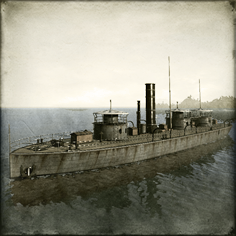
Basic Unit Statistics (can be modified by difficulty level, arts, skills, traits and retainers)
| Recruitment Cost | 7200 | |
| Upkeep Cost | 720 | |
| Marines | 40 | 33% |
| Seamen | 30 | 15% |
| Gunners | 24 | 14% |
| Accuracy | 10 | 14% |
| Reloading Skill | 10 | 25% |
| Hull Strength | 8000 | 80% |
| Morale | 19 | 38% |
Strengths & Weaknesses
- Medium-speed vessel
- Large crew
- Very good range and accuracy
- Strong armour
- Excellent morale
Abilities
- Fast Reload - This increases the reload skill of a ship's crew for a short period of time.
- Overheat Engine - This increases a ship's speed for a short period of time.
Requires
Description
Pride of the US navy, these large ironclad battleships have excellent firepower and crew morale.
These heavily armoured ships are screw driven, but it is their armament that sets them apart from other ironclads: they carry guns in Ericsson turrets which boast outstanding range and accuracy. The crew are armed with rifles and have excellent morale. The sheer size of these warships makes them ideal for large naval engagements at sea, but they are less suited to small scale port battles as they are less manoeuvrable than some of their smaller counterparts. The original USS Roanoke wasn't originally designed as an ironclad; when she was launched in December of 1855 she was a wooden-hulled steam frigate. When the American Civil War began she was re-commissioned and attached to the North Atlantic Blockading Squadron. It wasn't until June of 1863 that she was re-commissioned as an ironclad after a series of improvements undertaken at the Novelty Iron Works. She was given three revolving Ericsson turrets, but sea trials soon revealed that the heavy turrets caused the ship to roll dangerously when out at sea, and the newly reinforced hull still didn't have the strength to bear the weight of continuous firing. As a result she was assigned to harbour defence at Hampton Roads, Virginia. She remained in service until 1882 when she was eventually struck from the list and a year later sold for scrap.